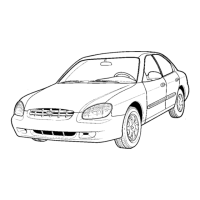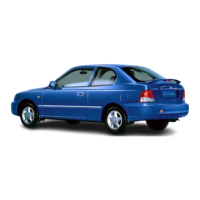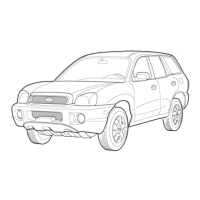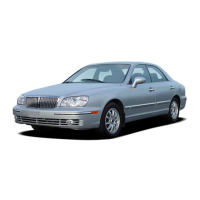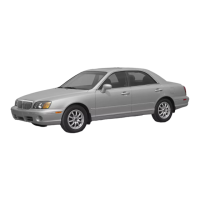Do you have a question about the Hyundai XG300 2001 and is the answer not in the manual?
Outlines the main sections of the owner's manual: Operation, Maintenance, and Specifications.
Warns against modifying the Hyundai, which can affect performance, safety, and warranties.
Advises on potential electronic interference from radios/phones and proper installation.
Defines WARNING, CAUTION, and NOTE titles used in the manual for clarity.
Guidance on using unleaded gasoline, gasohol, MTBE, methanol, and cleaner gasolines.
Advice on checking regulations and fuel availability when driving abroad.
Guidelines for the first 1,200 miles to ensure economical operation and durability.
Information on master keys, sub keys, and how to record and replace key numbers.
Details on the ignition switch light that illuminates when a door is opened.
Explains how to lock and unlock front doors from outside and inside.
Covers locking doors from inside, child-protector locks, and central door locks.
Details on how to lock the vehicle's doors from the outside.
Explains the Armed, Alarm, and Disarmed stages of the theft-alarm system.
Details on locking/unlocking doors and trunk release via remote.
Explains how to operate power windows, including driver-only controls.
Covers adjusting seats forward/rearward, seatback angle, and related warnings.
Warnings related to power window operation and child safety.
Details on adjusting headrests and safety warnings.
Explains how to adjust lumbar support on the driver's seat.
Covers adjusting seat cushion height for driver's seat.
Explains power seat adjustments and related safety cautions.
Details on reclining seatback angle and safety warnings.
Explains memorizing and activating driving positions.
How to use the front seat warmer.
Warnings about rear seat cargo and folding seatbacks.
General warnings, precautions for infants, small, and larger children.
How to use the rear seatback safety lock feature.
Proper usage for pregnant women, injured persons, and general warnings.
Covers inspection, cleaning, and maintenance of seat belts.
Instructions for adjusting height and safety warnings.
How to fasten the driver's seat belt and related notes.
Details on fastening passenger/rear belts and usage warnings.
Guidance on properly adjusting seat belts, especially lap belts.
Explains the rear center belt system and its release.
Specific warnings related to the rear center seat belt usage.
Guidelines and warnings for installing child restraint systems.
Procedures for installing child seats using anchors and belts.
How pre-tensioner seat belts work and associated warnings.
Details operational warnings, cautions, and safety advice for pre-tensioner seat belts.
Explains the SRS system, its purpose, and general warnings.
Lists SRS components and explains how the system monitors for deployment.
Explains how the system detects passengers and its relation to airbag deployment.
Covers SRS activation, warning lights, and cautions related to air fresheners.
Explains the purpose and operation of side airbags and related warnings.
Guidelines for cleaning SRS components and servicing the system.
Further warnings regarding SRS component tampering, replacement, and vehicle disposal.
Identifies various instruments and controls on the dashboard.
Explains various warning lights and indicators found in the instrument cluster.
Explains SRS, turn signal, seat belt, oil, high beam, and brake warning lights.
Covers charging, door ajar, low fuel, malfunction, and ABS indicator lights.
Explains fuel gauge, coolant temp gauge, cruise indicator, and brake wear warning.
Covers speedometer, odometer, trip odometer, and tachometer.
Details on turn signals, lane change, fog lights, headlights, and tail light auto-cut.
Operation of wiper/washer switch and safety notes.
Operation of high-beam, flasher, and auto light features.
Covers washer operation, mist wipe, and intermittent wiper modes.
How to activate and deactivate the hazard warning lights.
Operation of rear defroster and digital clock settings.
Explains modes like AVG. SPEED, DISTANCE, DRIVE TIME.
Details on Distance, Mile to Empty, Drive Time, and Reset functions.
Covers instrument panel lights, cigarette lighter, and ashtrays.
Details on drink holders and electric sunroof operation with safety warnings.
How to tilt the sunroof and operate it manually if electric fails.
Explains map lights, interior courtesy lights, and personal lights.
How to open/close the glove box and safety warnings.
Adjusting mirrors and related safety cautions.
Operation of mirror heater, folding mirrors, and day/night mirror.
How to engage and release the foot-type parking brake.
Using remote release, closing trunk lid, and safety warnings.
Operation of trunk lid lock knob and emergency release lever.
How to open the trunk using the key.
Information about the additional rear stop light.
Remote release operation and crucial safety warnings for refueling.
How to open the fuel filler lid manually if remote fails.
Operation of hood release and critical safety warnings for driving with hood open.
Proper use of car mat anchors and CD changer operation.
How to use sunvisors and related safety warnings.
Adjusting the steering wheel tilt and using illuminated vanity mirror.
Overview of the cruise control system and its function.
Detailed steps for setting, cancelling, resuming, and resetting cruise control.
How to reset cruise control speed and important usage warnings.
Explains fan speed, air intake, and temperature controls for HVAC.
Details on air flow directions, fan speed, and air intake settings.
Explains Face, Bi-Level, Floor, Floor-Defrost, and Defrost air modes.
Covers bi-level heating, general heating controls, and temperature adjustment.
How to operate the ventilation system, center, and side ventilators.
Steps to remove interior and exterior windshield fog and frost.
How to use AC for cooling, operation tips, and system switch.
Tips for maximizing cooling by adjusting temperature, fan speed, and recirculation.
Overview of the automatic HVAC system and its controls.
How the FATC system operates automatically and adjusts temperature.
Using ambient switch and manually controlling HVAC.
Details on fan speed, air intake control, system off, and air flow modes.
Explains defrost modes and provides tips for using the air conditioning.
Basic explanation of how AM/FM radio signals are received and processed.
Compares AM/FM reception and explains common signal issues like fading and static.
Discusses potential audio interference and cautions for using communication devices.
Identifies and explains controls for the H940A stereo radio.
Details on volume, tone, tuning, and how to preset radio stations.
Explains how to change radio bands and use EQ modes.
Identifies and explains controls for the cassette tape player.
Explains FF/REW, AUTO MUSIC SELECT, TAPE PROGRAM, EJECT, EQ, and DOLBY functions.
Identifies and explains controls for the H940A CD player.
Explains CD playback, FF/REW, TRACK UP/DOWN, SCAN, REPEAT, and EQ for H940A.
Identifies and explains controls for the H940A CD auto changer.
Explains CD auto changer usage, controls, and operational notes for H940A.
Identifies and explains controls for the H940C stereo radio.
Details on volume, tone, tuning, and how to preset radio stations for H940C.
Explains how to change radio bands and use EQ modes for H940C.
Identifies and explains controls for the H940C CD player.
Explains CD playback, FF/REW, TRACK UP/DOWN, REPEAT, and EQ for H940C.
Identifies and explains controls for the H940C CD auto changer.
Explains CD auto changer usage, controls, and operational notes for H940C.
Lists audio system fault codes, their causes, and solutions.
Proper handling, cleaning, and storage of CDs.
Guidelines for caring for cassette tapes and preventing damage.
Proper handling, storage, cleaning, and usage of cassette tapes.
How the glass antenna works for AM/FM reception and cleaning cautions.
Critical warnings about engine exhaust fumes and idling safety.
Steps to perform before starting the engine, including safety checks.
Explains the functions of LOCK, ACC, ON, and START key positions.
Step-by-step guide for starting the engine safely.
Overview of automatic transaxle, its positions, and shifting notes.
How to select and use sports mode for gear shifting.
Explains Park, Reverse, Neutral, and Drive positions with cautions.
Cautions for sports mode shifting and general driving practices.
Essential advice on safe driving, braking, and parking.
How TCS works, slip control, and driving hints.
Explains ABS function, limitations, and warnings.
Explains TCS ON/OFF modes, indicators, and warnings.
Advice on proper braking, including cargo safety and wet brakes.
Tips on tire care, alignment, cleaning, light travel, and economical driving techniques.
Advice on engine warm-up, smooth cornering, winter driving, and battery/oil checks.
Tips for freezing locks, washer fluid, parking brake, snow/ice, emergency kit, and pre-trip checks.
Information on hitches, chains, brakes, weight limits, and break-in period for towing.
Detailed advice on safe towing, including vehicle handling and trailer management.
How to handle overheating while towing and safe uphill driving/stopping.
Troubleshooting steps for engines that won't start or stall while driving.
Detailed procedure and safety warnings for jump starting.
Continues jump start steps and emphasizes battery safety precautions.
Steps to take if the engine overheats, including safety warnings.
Instructions and warnings regarding the temporary spare tire.
Steps to take if a tire goes flat while driving.
Steps for obtaining the spare tire and tools, and removing wheel covers.
How to block the wheel and loosen wheel nuts before jacking.
Instructions on placing the jack and safely raising the vehicle.
Steps for removing the wheel, installing the spare, and tightening nuts.
How to lower the vehicle and properly tighten wheel nuts.
Ensuring correct towing methods to prevent vehicle damage.
Specific instructions and cautions for towing vehicles with automatic transmissions.
Procedures for emergency towing without a commercial service.
What to do if keys are lost or locked inside the vehicle.
Owner's role in achieving long-term corrosion resistance for the Hyundai.
General advice on keeping the car clean, especially the underside.
Importance of dry garages and keeping paint/trim in good condition.
Proper steps for washing, rinsing, drying, and waxing the car.
Preventing interior corrosion from moisture and cleaning spots.
Methods for cleaning vinyl and leather interior surfaces.
Instructions for cleaning windows and carpets, including rear defroster wiring care.
How to clean seat belts and inspect them for wear or damage.
Ensuring proper maintenance for optimal operation and warranty compliance.
Divides maintenance into scheduled procedures, general checks, and DIY tasks.
Outlines inspection timing, retaining service receipts, and intervals for severe usage.
Chart detailing inspection/replacement intervals for emission control items.
Chart detailing inspection/replacement intervals for general vehicle items.
Lists items requiring more frequent service based on driving conditions.
Guidance on engine oil and filter changes, especially in severe conditions.
Importance of fuel filter and drive belt inspection for vehicle operation.
Instructions for checking brake hoses, fluid, drums, pads, and calipers.
Guidance on inspecting exhaust, suspension mounting bolts, and steering components.
Diagram identifying key components in the engine compartment.
Regular checks for engine compartment, exterior, and interior components.
Importance of checking oil level and recommended oil types.
Steps for checking and adding engine oil, including disposal warnings.
Procedure for changing engine oil and filter, with safety precautions.
Guidance on checking coolant level and recommended coolant types.
Information on spark plugs, their replacement, and tightening.
Steps for changing engine coolant, including safety warnings.
Details on platinum-tipped spark plugs and their identification.
Important warnings and notes regarding spark plug replacement.
Procedure for replacing the air cleaner filter and related cautions.
How to fill the windshield washer reservoir and related cautions.
How to check transaxle fluid level and recommended fluid types.
Procedure for checking transaxle fluid level with the engine running.
Importance of checking brakes and brake fluid level with safety warnings.
How to add brake fluid carefully and safety warnings.
Keeping the condenser clean and checking AC operation.
Periodic checks for drive belt tension, wear, and routing.
How to check for and identify steering wheel free-play.
Checking brake pedal clearance with engine running and helper assistance.
Periodic checks for drive belt tension, wear, and routing.
How to check for blown fuses and replace them safely.
Precautions for working with batteries and checking battery condition.
Checking engine and condenser cooling fans for proper operation.
Checking power steering fluid level and hoses for leaks or damage.
Step-by-step instructions for replacing headlight bulbs with safety warnings.
Procedure for checking and adjusting headlight aiming.
Table listing all exterior and interior light parts and their wattages.
Explains the three main emission control systems and maintenance recommendations.
Explains how the catalytic converter works and provides safety warnings.
Locating the vehicle identification number (VIN) on the car.
Shows where the engine number is stamped on the engine block.
Guidance on tire information, inflation pressures, and their importance.
Advice on checking tire pressures and avoiding car overloading.
Guidelines for installing and using snow tires, including speed limits.
Instructions for installing tire chains on front wheels and minimizing wear.
When to rotate tires, check tightness, and replace worn tires.
Explains why tire balancing is important for handling and wear.
How to identify worn tires using indicators and tire replacement guidelines.
Information on purchasing a factory shop manual for detailed service information.
Overview of the limited warranty periods for new Hyundai vehicles.
Explains Treadwear, Traction, and Temperature grades for tires.
Warnings regarding traction grades and temperature grade limitations.
Provides key dimensions of the vehicle.
Details on power steering type, free play, rack stroke, and oil type.
Lists battery and alternator specifications.
Details on brake type, front/rear systems, and parking brake.
Specifies fuel tank capacity.
Lists standard and spare tire sizes and recommended pressures.
Details engine type, displacement, firing order, valve clearance, and oil grade.
Specifies oil and coolant standards and quantities for various vehicle systems.
Alphabetical index of topics from A to C in the manual.
Alphabetical index of topics from D to H in the manual.
Alphabetical index of topics from H to O in the manual.
Alphabetical index of topics from P to T in the manual.
Alphabetical index of topics from T to W in the manual.
| Brand | Hyundai |
|---|---|
| Model | XG300 2001 |
| Category | Automobile |
| Language | English |


